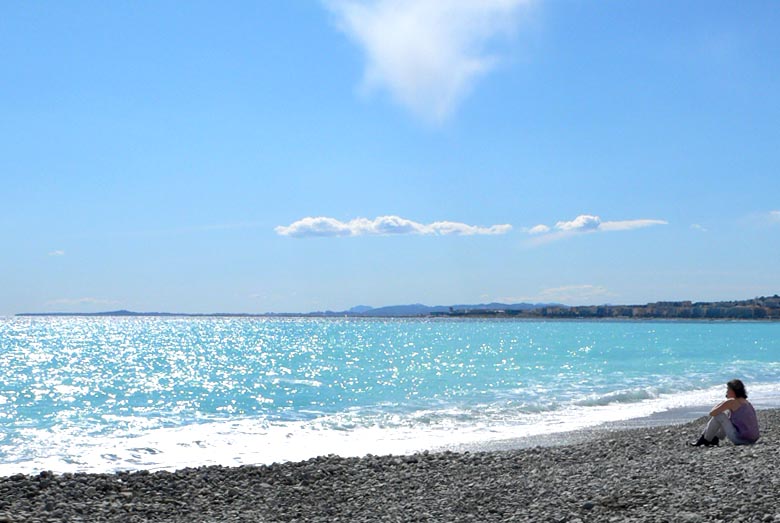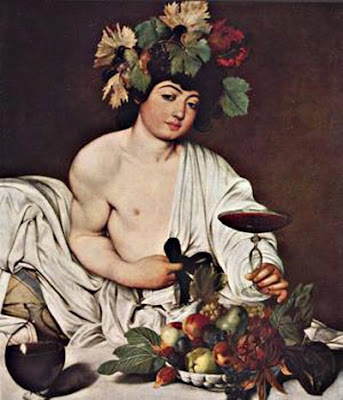Florence: Money, power, art
On Boxing day we set off from Nice for Florence. Luckily we had good weather, blue sky almost every day.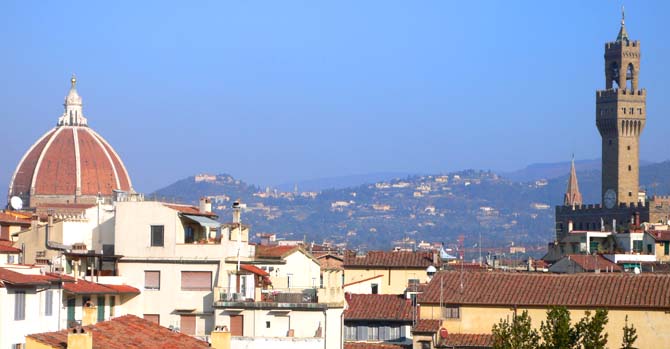
Florence from the Pitti Palace
A room with a view
We stayed just outside the centre, at the top of the Bobboli Gardens, which are behind the Pitti Palace. Our hotel was Villa Carlotta, with a nice view from our room which probably hadn't changed much in centuries: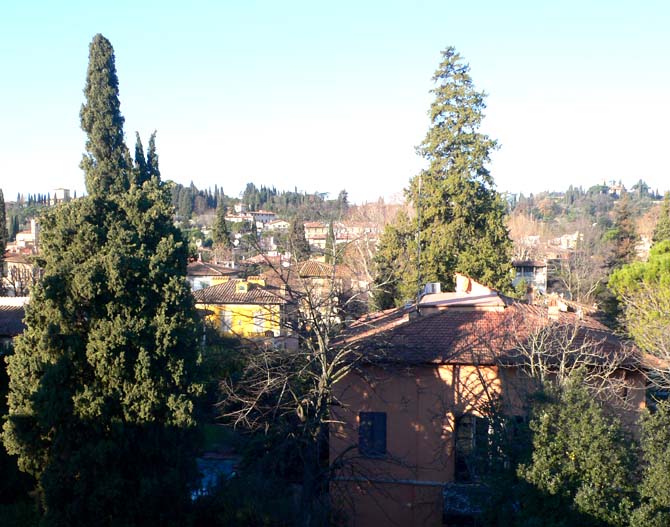
The first day we went to the nearby Pitti Palace - it was built by Pitti, a banker wanting to outdo the Medicis - one was supposed to feel awed and intimidated by the entrance, like the rest of the huge building (M is on the right). I detest the repressive power such places represent, M. prefers to focus on the nice decoration and art.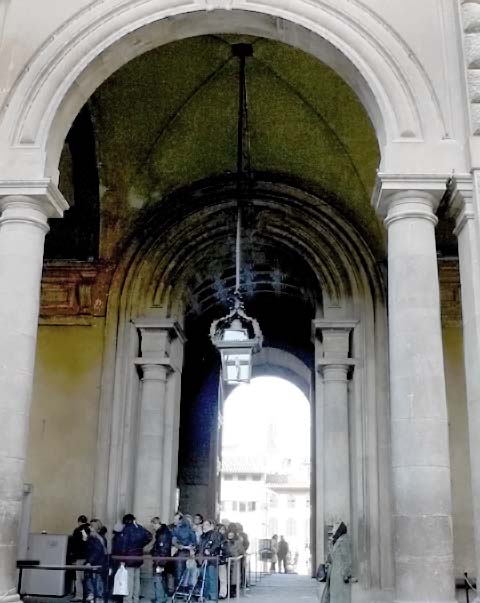
Pitti had always been one of the most authoritarian and antidemocratic members of Cosimo's [de Medici] coterie... he personally had called the 1458 parliament that put an end to republican opposition ... as an extremely wealthy banker in the process of completing a palazzo that was intended to surpass any in town, Luca had no intention of bending the knee to anyone now Cosimo was gone.
Medicis and Money, Tim Parks, p.155
Ironically it was bought by the Medici family in 1539.
The impressive interior, with classical statues displaying the patron's cultured taste:
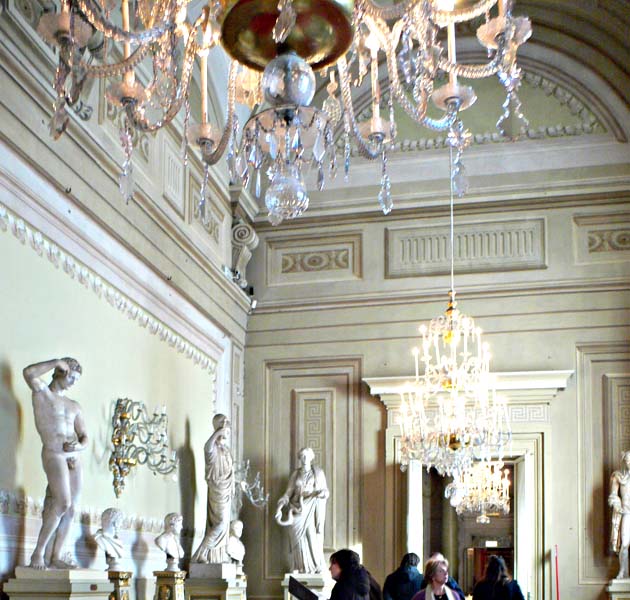
Me and a bit of macho classicism:

The statue does echoes the grim, violent reality of life in Italy during the Renaissance, which is vividly portrayed in the autobiography of Cellini:

He even writes in a complacent way of how he contemplated his murders before carrying them out. He writes of his time in Paris:When certain decisions of the court were sent me by those lawyers, and I perceived that my cause had been unjustly lost, I had recourse for my defense to a great dagger I carried; for I have always taken pleasure in keeping fine weapons. The first man I attacked was a plaintiff who had sued me; and one evening I wounded him in the legs and arms so severely, taking care, however, not to kill him, that I deprived him of the use of both his legs. Then I sought out the other fellow who had brought the suit, and used him also such wise that he dropped it.
http://en.wikipedia.org/wiki/Benvenuto_Cellini
Very vivid, too, is the impression we receive of the social life of the sixteenth century; of its violence and licentiousness, of its zeal for fine craftsmanship, of its abounding vitality, its versatility and its idealism. For Cellini himself is an epitome of that century. This man who tells here the story of his life was a murderer and a braggart, insolent, sensual, inordinately proud and passionate; but he was also a worker in gold and silver, rejoicing in delicate chasing and subtle modelling of precious surfaces; a sculptor and a musician; and, as all who read his book must testify, a great master of narrative.
http://www.gutenberg.org/dirs/etext03/7clln10h.htm
The shadow of Cellini's Perseus in Piazza Signoria:

His name has commercial value today:
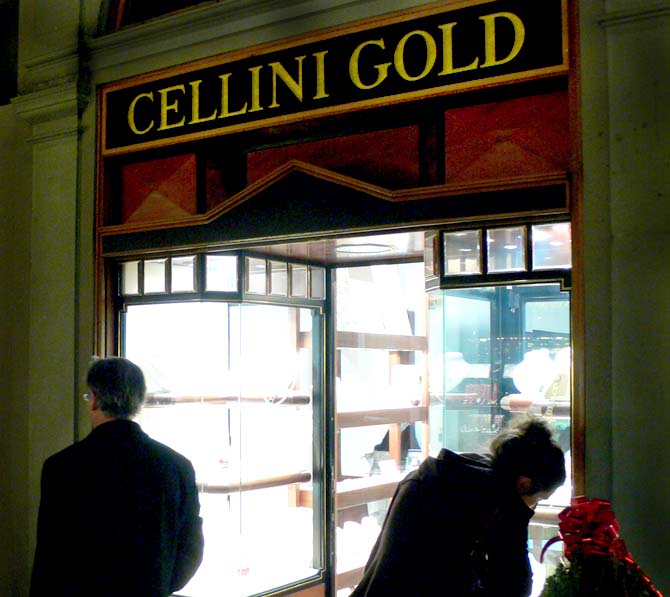
Palazzo Vecchio/Signoria where Cosimo Medici was once held prisoner for two weeks while his rival, Albizzi, argued for his execution - because exile didn't work with bankers as it did with the aristocracy who were dependent on their land - money is easily moved:
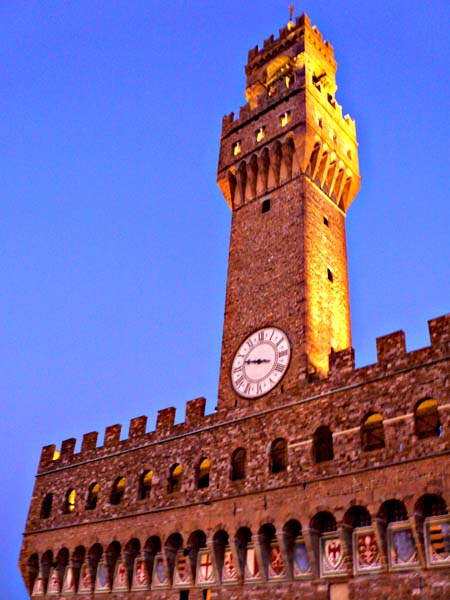
It looks very nice now in the winter sun, it looked very different after the Pazzi plot against the Medicis in April 1478, which involved the assassination of Guiliano Medici, but Lorenzo - "the Magnificent" escaped:
Revenge is rapid and brutal. Archbishop Salviati, Francesco Pazzi, and scores of others, many innocent, are strung from the windows of the Palazzo della Signoria, or in some cases are simply tossed to their death from the highest floors.
Michaelangelo's David: Art and propaganda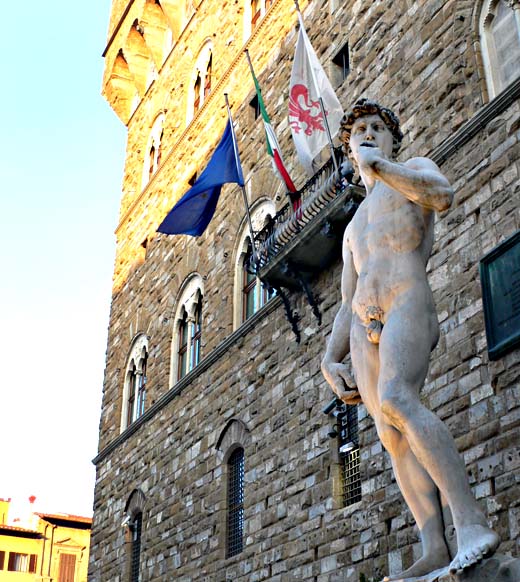
- The very famous David by Michelangelo, despite being originally commissioned in 1501 for a different destination, was immediately "taken" by the Florentine supporters of the Republic, with the aim of celebrating the victory (a temporary one) against the Medici family. The biblical hero, was intended to represent the Republic, and the Medici family was the giant Goliath, to the Republic's David.
http://www.tuscanjourney.org/art-history-in-tuscany/michelangelo-s-david/
But the Medicis returned to power. The Inscription put up on the Palazzo Vecchio by Cosimo Medici says: "Jesus, king of kings and lord of lords" - however, in Florence, the Medicis ruled again.
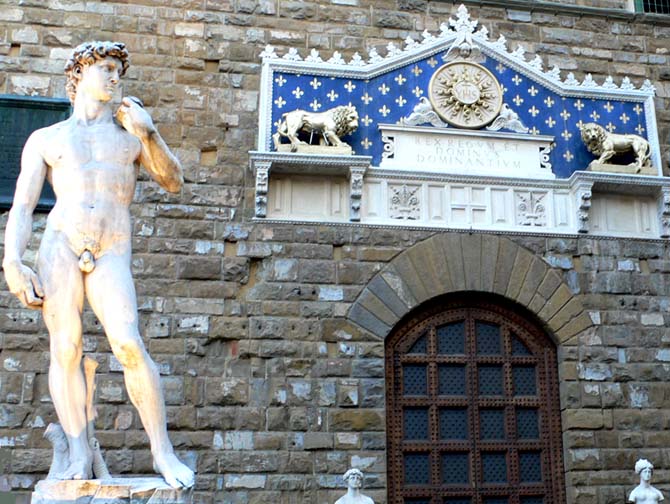
Art and sexuality
In the evening we had a meal near the Ponte Vecchio. On the wall on the left is Bacchus by Carravaggio, painted when sodomy was a crime, sometimes punishable by death, as it still is in some countries:
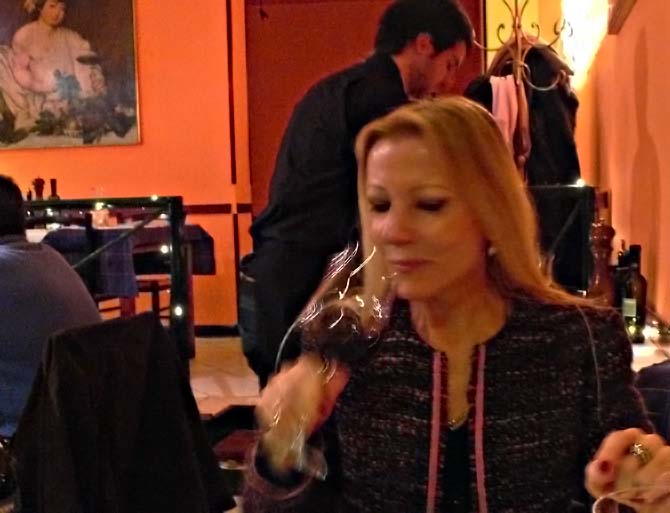
The Renaissance, inspired by the rediscovery of the philosophy and art of the Classical period, was also a new dawn for homoerotic expression. A male's desire for another male was primarily constructed as an adult's desire for an adolescent, beardless youth. Consequently, pederastic aesthetics influenced art and literature throughout Europe.
Among the luminaries of the time who praised or depicted romantic liaisons with youths were Théophile de Viau, Marsilio Ficino, Benvenuto Cellini, Caravaggio, Leonardo da Vinci, and Michelangelo.
...
At the same time, the Catholic Church, working through the Inquisition courts as well as through the civil judiciary, used every means at its disposal to fight what it considered to be the "corruption of sodomy". Men were fined or jailed; boys were flogged. The harshest punishments, such as burning at the stake, were usually reserved for crimes committed against the very young, or by violence. Not infrequently this was an internecine struggle, as those pursued were often enough men of the cloth.
http://en.wikipedia.org/wiki/Pederasty_in_the_Renaissance
The Golden View wine bar, with view across the Arno with tower of the Palazzo della Signoria. It was great to be able to get a table by the window during this relatively quiet period:

On the Ponte Vecchio the tourists come and go, dreaming of Michelangelo (with apologies to T.S.Eliot):

Or, in M's case, some jewelry:
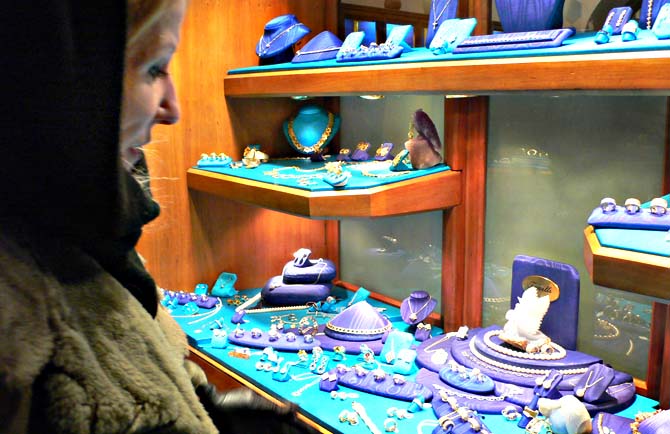
Some people faint at the beauty of Santa Croce (allegedly) - haven't they seen a beautiful woman? - no comparison:
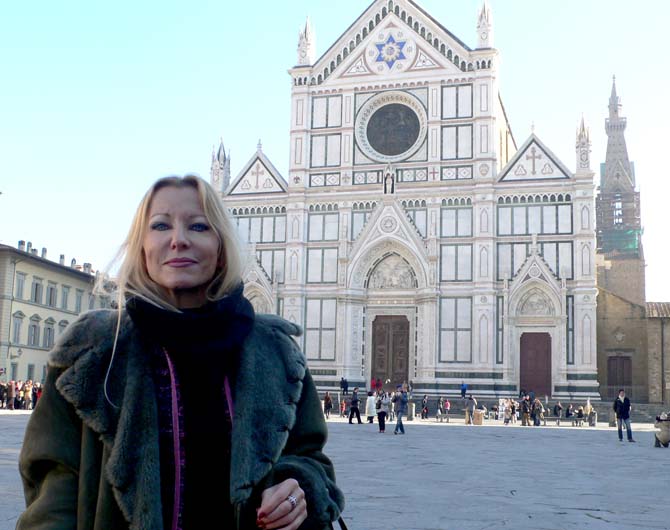
Tourist and living statue outside the Uffizi:
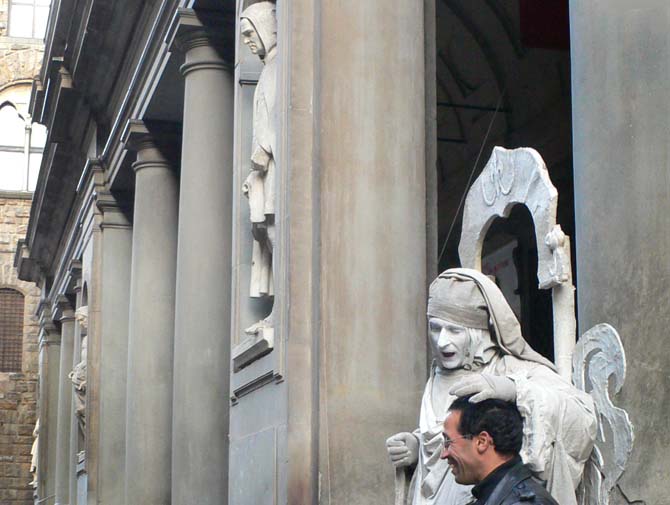
[It] was begun by Giorgio Vasari in 1560 for [yet again] Cosimo I de' Medici as the offices for the Florentine magistrates — hence the name "uffizi" ("offices")
...
Over the years, further parts of the palace evolved into a display place for many of the paintings and sculpture collected by the Medici family or commissioned by them. After the house of Medici was extinguished, the art treasures remained in Florence by terms of the famous Patto di famiglia negotiated by Anna Maria Lodovica, the last Medici heiress; it formed one of the first modern museums [1765].
http://en.wikipedia.org/wiki/Uffizi
My favourite place, Michelangelo's house, because intimate and uncrowded - but then we'd had to pass through an area with leather shops and bought some jackets, so we only got there just before closing time:
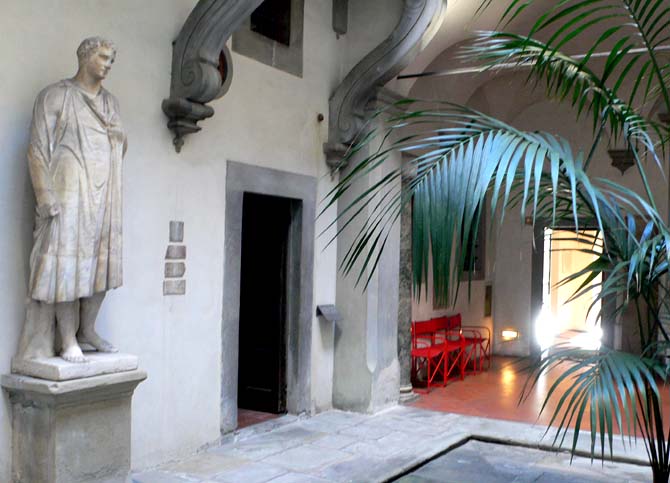
Mike and me:
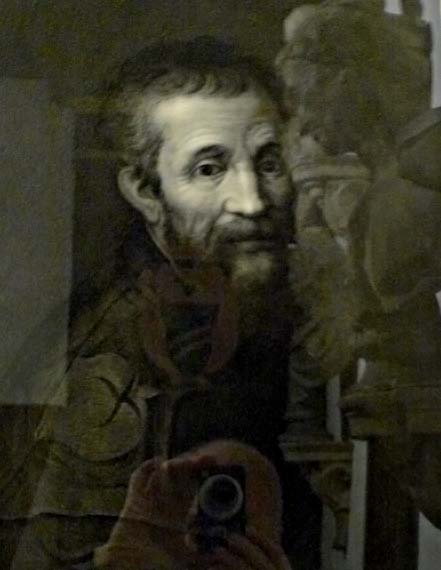
In Cellini's Autobiography he says he spoke to one of Michelangelo's fellow students, Piero Torrigiano, told him that it was he who had punched Michelangelo and broken his nose for what was apparently routine taunting of the others by Michelangelo (see his comment on Ammannati's Neptune below).
Michelangelo said Ghiberti's doors for the Baptistry could be the gates of heaven:
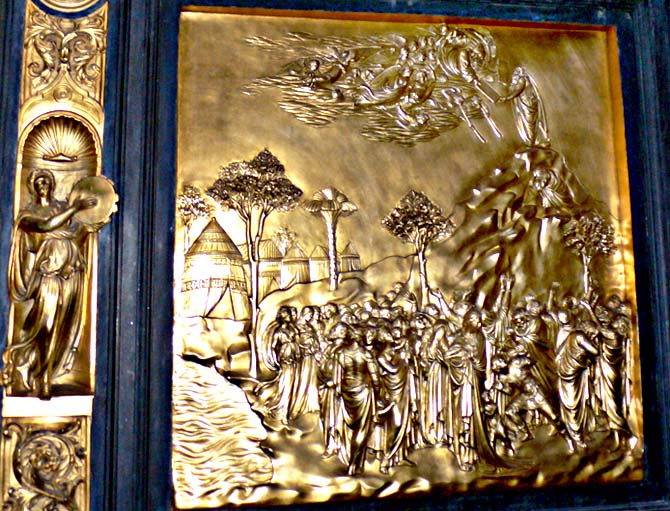
Me, trying to pretend I enjoy having my photo taken and in no hurry to enter heaven, even through these doors:

Xmas lights - late shopping, in streets which haven't changed much since the Renaissance (M on the right):
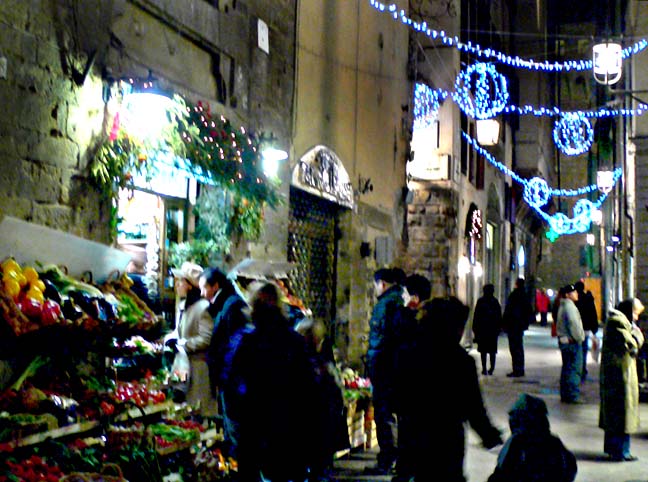
The Fountain of Neptune by Bartolomeo Ammannati - Piazza della Signoria:
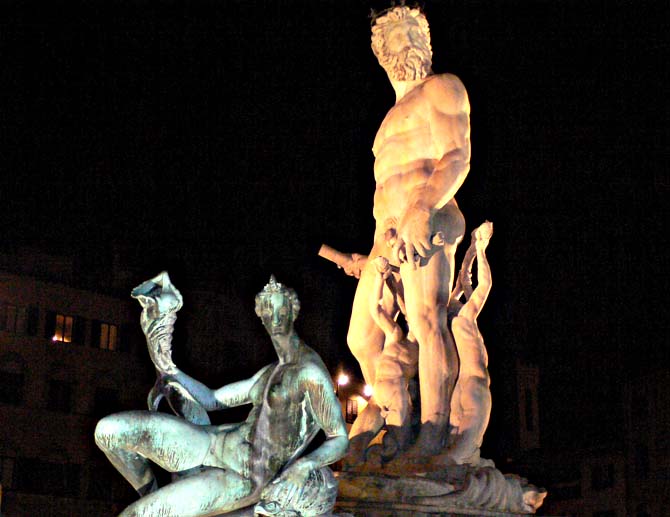
"What a nice piece of marble you've ruined"
He took Grand Duke Cosimo I as model for Neptune's face. When the work on the ungainly sea god was finished, Michelangelo scoffed at Ammanati that he had ruined a beautiful piece of marble. In fact, the piece was so universally disliked (even to this day) that the saying was: "Ammanati, Ammanato, che bell' marmo hai rovinato!" Translated: Ammanati, Ammanato, what a nice piece of marble you've ruined! Ammanati continued working on this fountain for another ten years, adding, in a mannerist style, around the perimeter suave bronze reclining river gods, laughing satyrs and marble sea horses emerging from the water.
http://en.wikipedia.org/wiki/Bartolomeo_Ammannati
Siena
We visited Siena on Sunday. After an interminable wait, we were storming out of a restaurant just as, of course, the waitress came out of the kitchen with our food, very apologetically. Then we spent too long in the cathedral for my liking - I felt that if I saw another fat cherub or pious madonna I'd scream - but M likes it all:
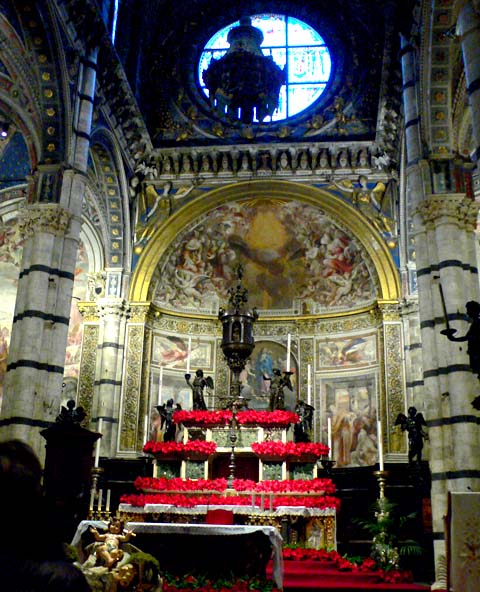
The Piazza del Campo, where the Palio horse race is held:

Power and money
This period was also crucial in shaping the Siena we know today. It was during the 1100s that the majority of the construction of the Duomo, Siena's cathedral, was completed. It was also during this period that the Piazza del Campo, now regarded as one of the most beautiful civic spaces in Europe, grew in importance as the centre of secular life. New streets were constructed leading to it and it served as the site of the market, and the location of various sporting events (perhaps better thought of as riots, in the fashion of the Florentine football matches that are still practised to this day).
...
On September 4, 1260 The Senese Ghibellines, supported by the forces of King Manfred of Sicily, defeated the Florentine Guelphs in the Battle of Montaperti.
... the Florentine army launched several fruitless attacks against the Senese army during the day, then when the Senese army countered with their own offensive, traitors within the Florentine army killed the standard bearer and in the resulting chaos, the Florentine army broke up and fled the battle field. Almost half the Florentine army (some 15,000 men) were killed as a result. So crushing was the defeat that even today if the two cities meet in any sporting event, the Senese supporters are likely to exhort their Florentine counterparts to “Remember Montaperti!”.
...
But the Florentines had the last laugh, and Medici money was involved again:
The Sienese government entrusted its defence to Piero Strozzi. When the latter was defeated at the Battle of Marciano (August 1554), any hope of relief was lost. After 18 months of resistance, it surrendered to Florence on April 17, 1555, marking the end of the Republic of Siena. The new Spanish King Philip, owing huge sums to the Medici, ceded it (apart a series of coastal fortress annexed to the State of Presidi) to the Grand Duchy of Tuscany, to which it belonged until the unification of Italy in the 19th century.
http://en.wikipedia.org/wiki/Siena
Siennese sausage shop:

Goodbye to the Arno and Florence, so lovely to look at, but with a history so full of oppression by the "suffocating" Church and aristocracy:
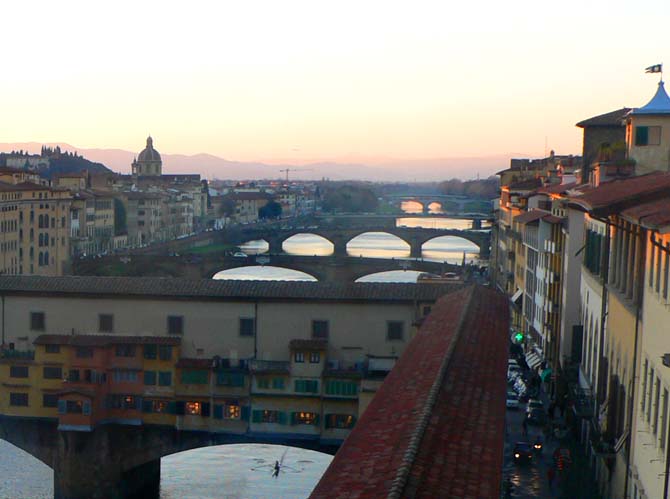
... having finally infiltrated to the highest levels the institution that had been the source of so much of their wealth , the Medici returned to Florence on the back of Vatican power and overturned the Republic. In 1529, they were officially recognized as dukes and ready to serve the Counter-Reformation in that long war of retrenchment that would keep an imitation of the older world - complete with those two complicit conundrums, the divine right of princes and the temporal power of the Church - in suffocating place for more than three hundred years.
Parks, p.246
Lunch at San Margherita Ligure on the way back to Nice on 31st Dec.

